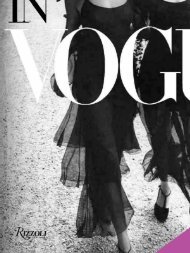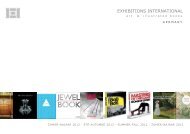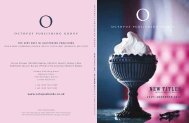pdf 1 - exhibitions international
pdf 1 - exhibitions international
pdf 1 - exhibitions international
Create successful ePaper yourself
Turn your PDF publications into a flip-book with our unique Google optimized e-Paper software.
Contents<br />
INTRODUCTION<br />
The Recycled Nude<br />
ONE<br />
The Nude: Its Life, Death and Resurrection<br />
TWO<br />
Body Art: The Journey into Nakedness<br />
THREE<br />
The Changing Room: Female Perspectives<br />
FOUR<br />
Forgive Me, I’m a Painter<br />
FIVE<br />
The Naked Portrait<br />
SIX<br />
After Rodin, Is There<br />
Anything Left To Say?<br />
SEVEN<br />
Going to Extremes<br />
NOTES<br />
SELECTED BIBLIOGRAPHY<br />
CREDITS<br />
INDEX<br />
This sales blad contains uncorrected proofs of<br />
sample pages in miniature. The full specifi cation<br />
for the book itself is:<br />
Trimmed page size: 28 x 21.4 cm<br />
Hardback<br />
192 pages with 130 illustrations, 116 in colour<br />
ISBN 978-0-500-23892-9 £28.00<br />
(price subject to change without notice)<br />
Thames & Hudson<br />
181A High Holborn, London WC1V 7QX<br />
www.thamesandhudson.com<br />
FRANCES<br />
BORZELLO<br />
The Naked Nude<br />
FRANCES BORZELLO<br />
The<br />
Naked<br />
Nude
Jemima Stehli, Strip, 2001, set of ten chromogenic photographs mounted<br />
on aluminium. In the photographic Strip series, Stehli gradually removes her<br />
clothes in front of five men from the art world (representing the male gaze).<br />
She asked each to use a cable shutter-release to photograph her during her<br />
striptease. Her aim was to record the response of a male caught in a position<br />
of some vulnerability as he is looked at while he looks.<br />
50 Body Art: The Journey into Nakedness<br />
51<br />
Naked_Nudes_Blad_spreads.indd 50-51 21/02/2012 12:59<br />
62<br />
The Changing Room: Female Perspectives<br />
LEFT Paula Modersohn-<br />
Becker, Self-Portrait, 1906,<br />
oil on card. Surely art’s first<br />
naked, pregnant self-portrait,<br />
Modersohn-Becker’s painting<br />
was made, according to its<br />
inscription, on the occasion of<br />
her sixth wedding anniversary.<br />
As far as is known, she was<br />
not pregnant when she<br />
painted it, which suggests<br />
that this is a work of personal<br />
exploration as she wonders<br />
about the effect of pregnancy<br />
on her life.<br />
OPPOSITE Lotte Laserstein,<br />
Morning Toilette, 1930, oil on<br />
panel. The large feet, sensible<br />
hair cut and sturdy legs of<br />
Laserstein’s depiction of her<br />
model washing suggest<br />
strength and purpose and are<br />
far from the passive female<br />
body beloved of male artists<br />
of the past.<br />
Naked_Nudes_Blad_spreads.indd 62-63 21/02/2012 12:59<br />
masculine imaginings of a frightened girl by stressing her gawky subject’s difference<br />
from the younger adolescents that form the frieze behind her. By extending the young<br />
girl’s arms and legs, the artist emphasizes the idea of a body that runs slightly ahead of<br />
its owner. There is less stress on sexuality than in the Munch and more on the strange<br />
new body changes, which must surely stem from a female insider’s point of view.<br />
It has been assumed that in the absence of any opportunity to study the life<br />
model, something men took for granted, women in the past who were serious about<br />
their art would try to learn about the body from drawing themselves without their<br />
clothes on. Gwen John did several watercolours and drawings of herself naked in<br />
her Paris apartment. To make money to support herself in Paris, she modelled, and<br />
one of the people she modelled for was Auguste Rodin. The inevitable happened but<br />
unfortunately, as also tends to happen, her passion outlasted his. A watercolour of<br />
herself sitting on a bed naked, painted about 1908–9, is one of a fascinating group of<br />
LEFT Edvard Munch,<br />
Puberty, 1894–5, oil on<br />
canvas.<br />
FAR LEFT Elena Luksch-<br />
Makowsky, Adolescentia,<br />
1903, oil on canvas.<br />
Munch seems to emphasize<br />
the sexual terrors of the young<br />
girl sitting self-protectively on<br />
the bed. In contrast, Elena<br />
Luksch-Makowsky<br />
concentrates on the physical<br />
gawkiness of the young<br />
woman’s arms and legs,<br />
which seem to be growing<br />
rapidly away from her.<br />
Gwen John, Self-Portrait<br />
Sitting Naked on Her Bed,<br />
c. 1908–9, gouache and<br />
pencil on paper. Gwen John’s<br />
watercolours and drawings of<br />
herself reveal her confidence<br />
in the body that had been<br />
brought to life by her lover,<br />
the sculptor Rodin.<br />
60 The Changing Room: Female Perspectives<br />
61<br />
Naked_Nudes_Blad_spreads.indd 60-61 21/02/2012 12:59<br />
bodily appearance and the historical one of idealization.’ However, his way of doing so<br />
is extremely singular for an artist. He has no desire for the casts of his body to carry any<br />
aesthetic value or interest in their own right. Instead, their value lies in the uses to which<br />
he puts them. ‘I think of the work as a catalyst or resonator whose value or significance is<br />
not intrinsic but is generated in relation to the viewer and to its context.’ 5<br />
Since 1997 Gormley has been populating a series of landscapes with iron casts<br />
of his own body. Among the most ambitious of Gormley’s sited sculptures is Horizon<br />
Field, situated high in the Austrian Alps and composed of a hundred iron bodies spread<br />
over seven valleys with all of the sculptures positioned at a height of 2,039 metres to<br />
create an artistic field that makes its own horizon. He says such works represent his<br />
attempts to ask a simple question in material terms: Where does the human being fit<br />
in the scheme of things? ‘Sculpture doesn’t need a roof or a label. You don’t need to<br />
pass over the threshold of an institution in order to experience something that engages<br />
your imagination and, with luck, your body. When placed in the outdoors in rain and<br />
sunshine, in summer and winter, in daylight and moonlight, sculpture, in my view,<br />
begins to live and its silence becomes a potent marker in time and space. People may<br />
well ask “What the hell is this thing doing here?” and the work returns that question and<br />
it responds reflexively “What the hell are you doing here?”.’ 6<br />
Despite Gormley’s denial of the usefulness of the art of the past, it is hard to<br />
divorce his nudes from it, even if just as a point of comparison. There is something of<br />
Ron Mueck, Dead Dad,<br />
1996–7, mixed media.<br />
Everything about this work<br />
operates in opposition to the<br />
notion of the ideal nude.<br />
Instead of generalized<br />
perfection, Mueck<br />
reproduces every wrinkle, hair<br />
and vein in his detailed<br />
portrait of his father’s body.<br />
the Renaissance about his goal of using his body as a kind of surrogate for us to view<br />
the world. Is that so very different from the miraculous one-point perspective of<br />
the 15th century, which offered an optimum spot from which the viewer could see a<br />
painting in its full three-dimensional glory? A journalist once put this link to humanity<br />
and to the sculptural tradition in a less elevated manner: ‘Some lonely art lovers have<br />
probably spent more time scrutinizing his rough-cast bottoms than they have a living<br />
human’s. In the world of sculpture only Michelangelo’s David and the Venus de Milo<br />
are more gawped at.’ 7 In 2011 Gormley faced up to his sculptural heritage – literally.<br />
Invited to show at the Hermitage in St Petersburg, he ‘deplinthed’ a group of classical<br />
sculptures by sinking them into a false floor, enabling visitors to come face to face with<br />
these personified icons of human character at its best. For the adjoining courtyard, he<br />
constructed a group of pixelated, blocky humanoids, crumbling and wavering in the<br />
confusions caused by life today. His aim was to present a modern dystopian contrast to<br />
the classical confidence of the perfect body.<br />
Hyperrealism and change of scale are the tools of Australian sculptor Ron<br />
Mueck, who has taken great pains to leave behind the traditional materials of sculpture<br />
and to choose as subjects any body other than the ideal. His sculptures seem closer<br />
to the art of making waxworks than to the bronzes and marbles of high art. Mueck is<br />
Ron Mueck, Mother and<br />
Child, 2001, mixed media.<br />
A first in the history of art is<br />
this larger-than-life sculpture<br />
of a mother and newborn<br />
child with attached umbilical<br />
cord. Its replacement of the<br />
classical ideal of exterior<br />
perfection with the interior<br />
functions of the body makes<br />
this indisputably a nude for<br />
our time.<br />
148 After Rodin, Is There Anything Left to Say?<br />
149<br />
Naked_Nudes_Blad_spreads.indd 148-149 21/02/2012 12:59


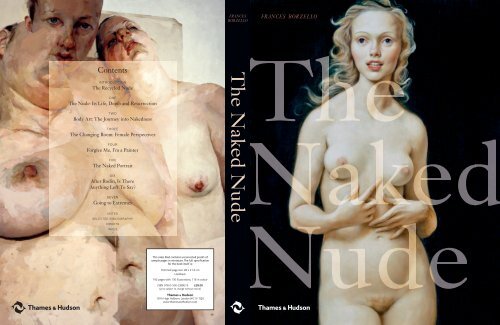
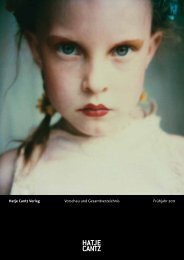

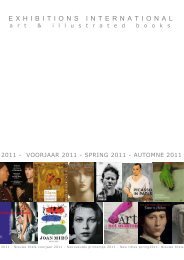
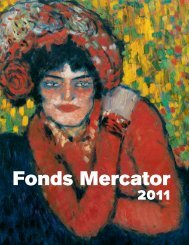
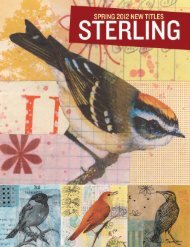
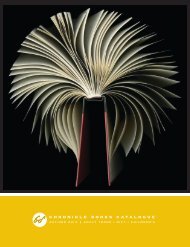
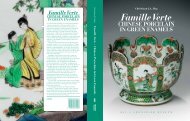
![01 -[BE/INT-2] 2 KOL +UITGEV+ - exhibitions international](https://img.yumpu.com/19621858/1/184x260/01-be-int-2-2-kol-uitgev-exhibitions-international.jpg?quality=85)

